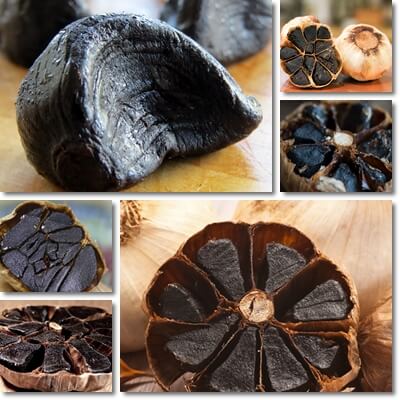What is black garlic? Black garlic is essentially aged garlic. Because of the conditions in which it is aged and the specific chemical reactions that take place during the aging process, the garlic browns and ultimately blackens, developing particular flavors. It is obtained from fresh garlic (Allium sativum) that is heated at 60-70-80 degrees Celsius in high humidity conditions, for 4 weeks or more. The specific conditions required to make black garlic cause amino acids and reducing sugars in the cloves to react with one another causing the browning and then blackening of the cloves. This is what is known as the Maillard reaction, a chemical reaction also responsible for the color and taste of chocolate, roasted coffee, roasted nuts, bread crust, French fries or seared meat.
What is fermented black garlic?
As mentioned above, black garlic is obtained through heating, as a result of the Maillard reaction, a chemical reaction that causes the browning of foods. But garlic is not a sterile food – it naturally contains microorganisms such as bacteria, fungi or yeasts. These microorganisms participate in the transformation process of the cloves. By heating the bulbs at 60-70-80 degrees Celsius in high humidity conditions for an average of 4 weeks, existing microorganisms survive and become agents of fermentation, contributing to the properties, appearance and taste of the aged cloves, hence the name fermented black garlic. Unless it is specified that fermenters or yeasts have been intentionally used to make the final product, then fermented black garlic is synonymous with aged black garlic or simply black garlic. Not to be confused with black garlic (Allium nigrum) which is a species of wild onion, sometimes cultivated for ornamental purposes.

How to make black garlic
Because it takes so long to make it, black garlic is both an expensive and rare food item. As such, many people choose to make it themselves at home. The exact process has many variables, but generally involves either a slow cooker, rice cooker or a black garlic fermenter machine (which you can find online). Basically, fresh garlic heads are aged in one of these machines for 4 weeks on average, at a temperature of 60-70-80 degrees Celsius, sometimes as high as 90, all whilst maintaining an 80-90% humidity level so that the cloves don’t dry out. In some settings, it is aged for 60 to 90 days, or 2-3 months. The bulbs are sometimes covered in several layers of tinfoil to prevent the cloves from losing moisture and drying out. No flavor or color additives are added to the cloves, the entire process being a natural one, reliant on heat and humidity alone. Even so, appearance and taste may differ slightly from one batch to another, from one manufacturer to another.
What does black garlic look like?
At the end of the aging process, the garlic heads have slightly brownish, papery skin and pitch-black cloves. The cloves may look a little bit drier as well compared to fresh ones, but are nonetheless soft, jelly-like and moist, giving into pressure easily. Exact processing condition can influence the way black garlic looks. For example, a lower processing temperature (60 degrees Celsius) slows down the aging process and can result on brown and dark brown cloves, rather than black. A temperature of 70 degrees Celsius is optimal.
What does black garlic taste like?
Black garlic has a mild, but deep, warm, rich taste profile, without the pungency of the fresh cloves. The cloves taste is overall sweet, with a faint bitter aftertaste reminiscent of molasses or burnt sugar syrups or even caramel. Other noticeable flavors include light vinegary or acidic and sour notes, but no sharpness. Black garlic cloves are soft, moist, sticky and gelatinous in texture, vs fresh cloves which are crisp, juicy, strong-flavored and biting. Of course, flavor profile may differ slightly depending on the batch, manufacturer, aging time and quality of the raw materials used. For example, the higher the processing temperature (90 degrees Celsius), the faster the aging and the stronger the bitter flavors.

Black garlic recipes
The taste of black garlic is mellow and can easily be overpowered by stronger-tasting foods. If you are considering incorporating it into day-to-day recipes, remember to pair the dark delicacy with mild-tasting or bland foods such as cauliflower mash, mashed potatoes, but also chicken, risottos or fish. Another great pairing is black garlic with honey – press the cloves until they become a soft, sticky paste and mix well with a honey of your choice (unless you are allergic). Then use this as a dressing for your favorite dish. Choose your favorite honey and find out all about its properties and health benefits on the Honey page.
Nutritional information
There is currently little to no information available on the nutritional value of black garlic. What is known at this time is that black garlic has a higher antioxidant content compared to fresh garlic (roughly 4 to 5 times higher). Studies show that the antioxidant values of the aged cloves may vary depending on the initial nutritional value of the cloves which, in turn, differs according to factors such as soil quality and other growing conditions. Antioxidants present in the aged cloves include flavonoids and other polyphenols, but also intermediate by-products of the Maillard reaction. See the nutritional information and benefits of red garlic.
Black garlic health benefits
Here is a list of the therapeutic properties and potential health benefits of eating the darkened cloves:
- Free radical-scavenging properties thanks to a 4-5 times higher antioxidant content compared to fresh garlic.
- Studies show black garlic has anticancer properties, inducing apoptosis or cell death in human leukemia cells, activating apoptosis and stopping the growth of colon and stomach cancers and exhibiting toxic effects on liver, stomach, lung and breast adenocarcinoma cells.
- Animal studies show the darkened cloves hold hepatoprotective properties, protecting against liver damage.
- Benefits for diabetes: animal studies show supplementation with black garlic resulted in decreased body weight, especially central/abdominal weight, and improved triglyceride and LDL cholesterol levels as well as lower serum glucose levels (aka lower blood sugar levels).
- Cardiovascular benefits: thanks to positive effects on blood lipid levels, notably lower triglycerides and LDL (bad) cholesterol and higher HDL (good) cholesterol levels.
- Other potential benefits: immune system modulating properties, anti-allergic and anti-inflammatory activity and improved memory and brain function.
